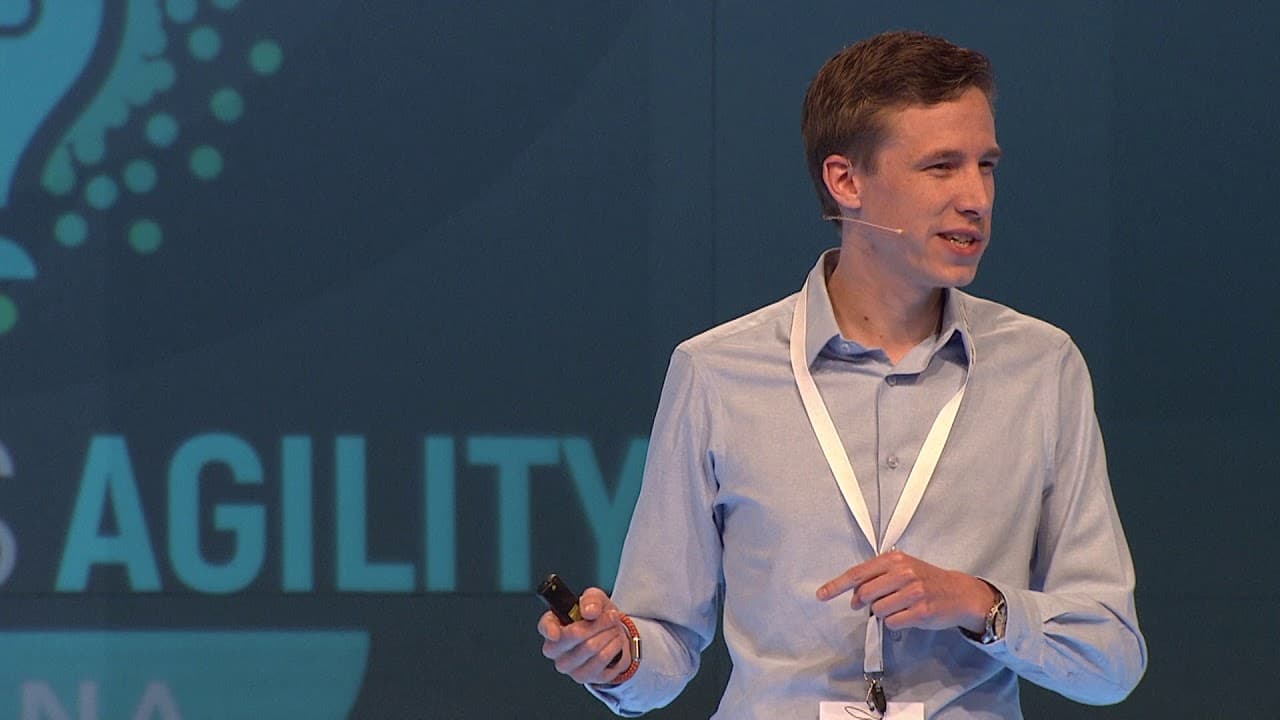A very warm welcome to the afternoon session. I wanted to share the story of our company's transformation over the past five years.
As Evan already introduced me, I’ll skip a detailed introduction, but for context, I was a product owner before joining a consulting company. I have a background in science, having studied electronics, and as a consultant, I travel frequently. Our company has a strong focus on agility, supporting corporations in adopting Agile methodologies. We are a very project-driven organization, treating every consulting assignment as a distinct project with dedicated teams, objectives, and adaptable timeframes.
We are also highly growth-oriented, which I’ll illustrate with a slide later. Over the past few years, our company has expanded significantly. Our team is diverse, with colleagues from various educational backgrounds, including law, psychology, and IT project management. We operate across Germany, Austria, and Switzerland, acting as change agents for our clients.
Growth and the Need for Reorganization
Founded in 2009, our company grew to 25 people by 2013-2014 when I joined. As Agile became more widely adopted, we expanded to over 60 people. In our organization, reorganization is not an occasional event but rather a continuous process. We constantly encounter new organizational thresholds that require adjustments in processes, structures, and governance.
Initial Team Structures (Pre-2013)
Before 2013, with only ten employees, there was no need for structured teams. The founder and managing director led the company directly, and it worked well. However, by 2013, with around 15 people, we needed a structure.
The first approach was quite traditional: the managing director appointed three of the most experienced colleagues as team leaders. Employees were randomly assigned to these teams, with some geographic consideration. These new team leaders were responsible for all disciplinary duties.
Transition to Agile Team Structures
Given that we advocated Agile principles to clients, our traditional internal leadership model felt contradictory. The next logical step was implementing Scrum. We grouped colleagues by client projects, assigning key account managers as product owners, responsible for contracts and business development. A voluntary Scrum Master was elected within each team to improve productivity.
With this shift, we moved from disciplinary leadership to a more lateral model. The only remaining disciplinary leader was the managing director, who handled performance management.
To balance supply and demand, we introduced a marketplace concept—a virtual chat room where consulting assignments and available capacity were posted. Employees could volunteer for projects based on interest and availability. This fostered self-organization, engagement, and empowerment.
Challenges with the Scrum-Based Structure
This structure lasted for about a year, but we identified several issues:
- Many colleagues worked alone with clients and didn’t belong to any team, leaving them disconnected.
- Some employees worked for multiple clients, leading to divided focus and inefficiency.
- Frequent team changes, due to short-term consulting assignments, disrupted team cohesion, making it difficult for Scrum Masters to develop high-performing teams.
The Next Step: A More Self-Organized Structure
By 2016, with 35 employees and expectations of further growth, we needed a new approach. In April 2016, at a town hall meeting, our founder announced a fundamental shift: a move toward a self-organized, network-based structure.
Employees were given 20-30 minutes to decide whether to found a team immediately. Each team founder was designated as the product owner, responsible for return on investment, and tasked with building a team around an inspiring vision that generated business value. After presenting their visions, employees could freely choose which team to join.
Initially, I was surprised—even shocked—by the short timeframe to decide. However, since I had been in the business for a few years, I was eager to take on responsibility. I decided to found a team focused on incubating startup spirit within large corporations.
Early Challenges in the New Structure
The next few months were a rollercoaster of emotions. While the excitement was high, we quickly encountered difficulties:
- One product owner failed to attract any team members. His focus—adopting Agile in ERP environments—was generating business but lacked appeal.
- Some employees chose not to join any team, isolating themselves.
- Some teams had inspiring visions but failed to generate business, leading to their eventual dissolution.
- One team grew too large (16 people) before splitting into three separate teams after 18 months.
The Leadership Challenge
Leading a team that voluntarily joins you is far more challenging than traditional leadership. Founders had to continuously refine their vision and create an environment where people could thrive, or risk losing team members to other teams.
Refining the Model: Guidelines for Teams
At the end of 2016, after an eight-month retrospective, we introduced guidelines to improve sustainability:
- First client must be contracted: Ensures business viability before forming a new team.
- Senior mentorship: Each new team must have a senior colleague sponsor for guidance.
- Team size cap: Maximum of 10 members per team to maintain agility.
- Minimum six-month commitment: Employees must stay in a team for at least six months before switching.
- Joint financial guarantees: Bonuses are tied to company-wide performance, discouraging silos.
Three Years Later: The Results
Now, more than three years later, we still follow this structure. While it’s not necessarily the “best” model, it is a better operating system for us. Employees can choose where to contribute, fostering motivation and engagement. Both employee satisfaction and financial results have improved.
That said, the journey has been challenging, even for Agile coaches. Change is difficult, especially when it directly affects personal routines.
Further Autonomy and Challenges
We increased team autonomy, allowing teams to manage their own marketing, sales, and recruitment. Initially, teams attempted to "steal" colleagues from each other, but after granting them the power to recruit externally, they began attracting new talent instead.
Current Improvement Initiatives
- Better alignment across teams: Teams became too independent, so we introduced OKRs (Objectives and Key Results) to align company priorities.
- Managing supply and demand: Smaller teams make balancing workload harder, requiring better coordination.
- Enhancing cross-team collaboration: Encouraging mutual support between teams.
- Redistributing leadership responsibilities: The product owner role was overburdened with disciplinary tasks. We shifted people development to Scrum Masters and strategic decisions to guilds.
Conclusion
Our journey has shown that agility is not just about frameworks—it’s about adaptability, continuous learning, and enabling people to thrive. While our structure is not perfect, it empowers employees, improves satisfaction, and supports business growth.
I hope this story has provided useful insights. Thank you for listening!



 Back in 2014 the company had about 20 employees and a classic organizational structure model which consisted of three traditional disciplinary managers, who were responsible for their team members. As this simply doesn't felt right for a company that advises other's in adopting an agile mindset, we moved in a first step to a team model, which was centered around the client projects.
Back in 2014 the company had about 20 employees and a classic organizational structure model which consisted of three traditional disciplinary managers, who were responsible for their team members. As this simply doesn't felt right for a company that advises other's in adopting an agile mindset, we moved in a first step to a team model, which was centered around the client projects.